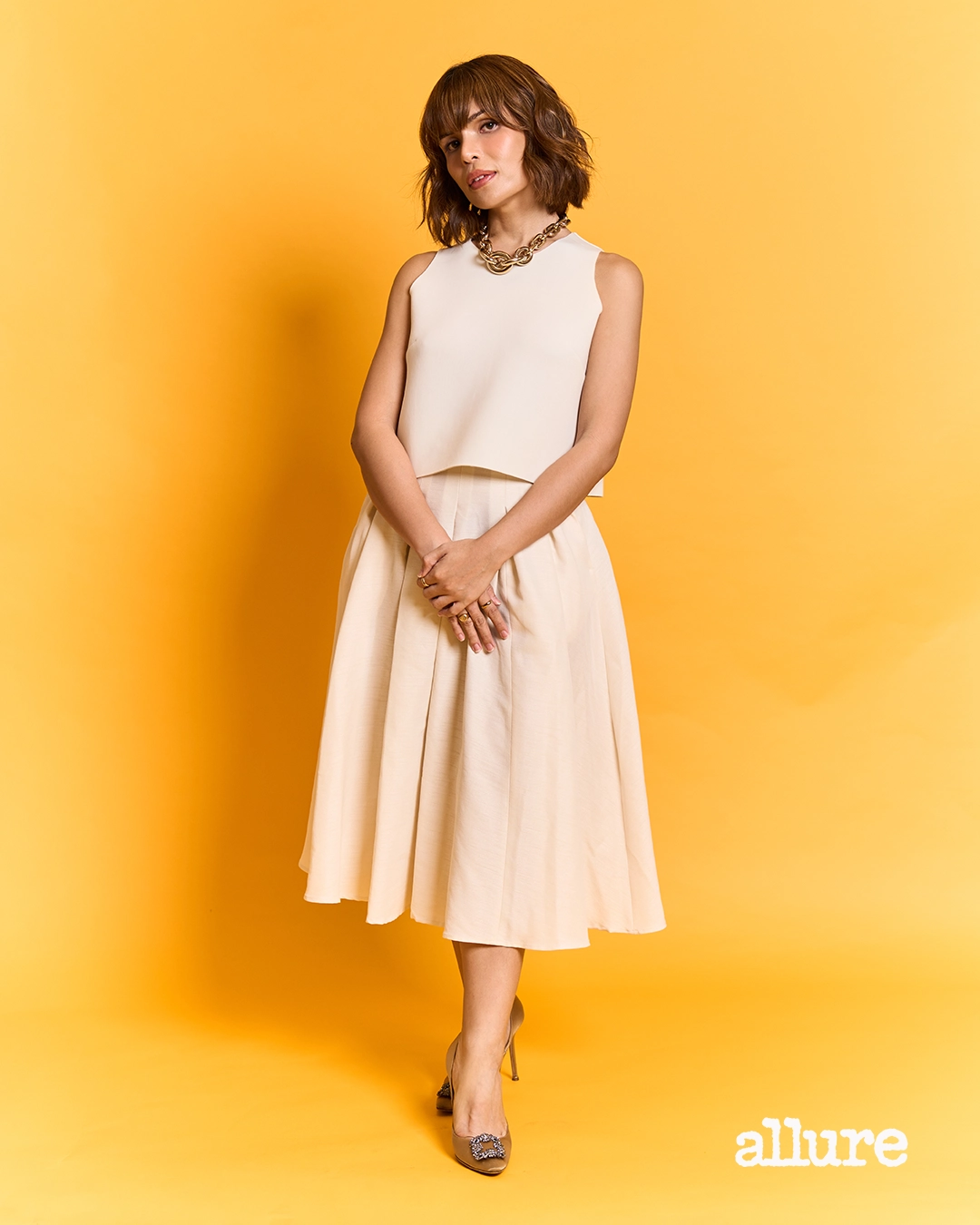Transcending Labels and Reclaiming Beauty, On My Own Terms
PR professional, LGBTQIA+ and HIV-AIDS advocate, and trans woman Janlee Dungca talks about the journey to living her truth.
Photographed by Kieran Punay
Twelve years ago, I was on my way to the beach when the thought of wearing board shorts and being topless made me squirm. I had identified myself as a woman, and to me, a woman is supposed to express herself in a feminine and beautiful way. I had consulted with an endocrinologist and my trans women friends, and I had been preparing for gender-affirming hormone therapy for months, but I never quite had the push, until that one fateful summer day.
Just hours before my flight, I bought my very first set of hormone pills and bikinis. And I never looked back. It might sound superficial to some, but I had never felt so free and alive as I did after taking those pills and wearing those bikinis. Having had the freedom to finally and truthfully express myself made me understand how it felt to be beautiful.
More than a decade has passed since I started my transition and my understanding of the lived experience of transgender people has since deepened. Being trans is a gender identity, which is our deeply felt internal and personal sense of being, which may or may not align with our sex assigned at birth (or sex characteristics). As a trans woman, I was assigned male at birth (by the doctor), but I currently identify as female.
Similar to the usage of the Latin prefix “trans” in the word “transport”, there is a journey from one point (my sex characteristics) to another (my current gender identity). I say currently because my gender identity can evolve as I go on through life and get to know myself better.
Transitioning, on the other hand, is not a type of gender identity, but a form of gender expression, which is our external presentation of our gender, including how we name, dress, behave, speak, move, and style ourselves.
Transitioning is unique to trans and nonbinary people (those who do not identify strictly as male or female). Though not required in order to be valid as trans or nonbinary, it is a process we may go through to live more authentically and fully, and to align our gender expression with our gender identity, rather than our sex characteristics. I could have opted out of transitioning by neither undergoing hormone therapy nor expressing myself in a feminine way, and that would not have made me any less of a woman.

Kieran Punay
Transitioning is multi-faceted
There are different types of transitioning. The first is psychological transition or the processing of internal identity shifts. This may require psychological support, especially for those who experience gender dysphoria (the psychological distress that some people experience when their gender identity doesn’t align with their sex characteristics). Fortunately, I didn’t experience gender dysphoria, which meant professional help wasn’t necessary. Nonetheless, I still needed to process what being a (trans) woman meant, through research and reflection, and by asking other trans women about their experiences.
The second is social transition or changing how we present or interact socially to reflect our gender identity. This can include using lived names and pronouns, coming out to family and friends as trans, and changing clothing, hairstyle and mannerisms. My most memorable experience of social transition was when I came out for the second time, as a trans woman (the first time was when I came out as a gay boy). I invited my family to dinner to tell them that I wasn’t a gay man, but a trans woman. They felt confused at first, but ultimately extended their understanding, acceptance and love.
The third is medical transition or making changes to our bodies using medical affirmations. This can include gender-affirming hormone therapy (like taking estrogen and/or testosterone supplements and/or blockers) and gender-affirming surgery (like top surgery, bottom surgery, facial feminization/masculinization surgery). In my experience, medical transition has really helped me feel more attuned to my body. I have come a long way from when I took my first set of hormone pills and wore my first set of bikinis. That moment has ultimately led to me feeling free, beautiful and happy.
And last is legal transition or updating our names and/or gender markers in all official documents and IDs to reflect our gender identity. This requires legislative support from the national government through a Legal Gender Recognition Law. Unfortunately, the Philippines still doesn’t have such a law which leaves trans Filipinos and Filipinas vulnerable from gender-based discrimination and violence. Our dream is to have a national law that will not just protect the safety of trans Filipinos, but will also promote our dignity.
Though they may seem like quite a handful, none of the four types of transitioning is required to identify or be valid as trans. Gender identity is self-determined, and should not depend on external factors. Trans people are not trans because we transition. We may transition if we choose to or if we are able to.
Transitioning is not about “becoming” another gender; it’s about aligning our lives with our gender identity. It can bring relief, joy, affirmation, and safety. But not everyone can transition, as it often comes with social and systemic challenges—whether it’s financially taxing, not allowed by family or religion, frowned upon in schools and the workplace, or not legally supported by the government.

Kieran Punay
The complexities of how we live
Living as a trans person involves understanding and navigating the complexities of being “passable.” In the trans community, “passability” refers to how well a trans person is perceived by others as cisgender (people whose sex characteristics and current gender identity are one and the same). This desire to “pass” is deeply tied to cultural standards of beauty. Many trans people feel pressured to conform to narrow, cis-normative ideals of femininity and masculinity just to feel validated and beautiful. These beauty expectations don’t just affirm gender identity. They reinforce a hierarchy that values those who “pass” more, making passability as much about beauty as it is identity.
As a trans woman, being passable means being seen as a cis woman by strangers. In a world that discriminates against trans people, it can be a safety or survival tool because being seen as cis can help avoid discrimination and violence. It can also be linked to gender dysphoria as some trans people feel more at ease when they are recognized as cis.
On the downside, the need to pass can also create pressure, anxiety and insecurity. In the Philippines, these pressures are compounded by a beauty culture shaped by media and advertising that often favors fair skin, Eurocentric features, and a narrow ideal of femininity, making the stakes of being “passable” even more intense and heavy.
My journey toward loving my body began when I decided to transition twelve years ago. In a cisnormative world, the more passable a woman is, the more she is seen as “real.” Many begin transitioning before male puberty to block masculine traits, so starting at 23, after developing irreversible features like an Adam’s apple or facial hair, is considered late.
I knew I wouldn’t be as passable as others, but I wasn’t focused on comparison. I was simply excited to live as the woman I truly am. Early in my transition, it felt like going through adolescence again—learning how to express myself, undergoing hormone therapy, and bridging the gap between how I felt inside and how I looked outside. I was excited to finally live my truth. At first, I thought I wouldn’t be affected by the pressure to be passable. But as time passed, I found myself drawn into it.

Kieran Punay
Transcending labels
Society holds high standards for women’s beauty, and as a trans woman, I felt the pressure even more. To be beautiful, I felt I had to be passable, and not just passable, but beautiful enough. I pursued surgeries and found myself comparing my looks with other trans women. The desire to be passable became addictive. Eventually, I had to pause and reflect on why I transitioned in the first place.
I didn’t transition to be perfect. Yes, I hoped to be passable, but that wasn’t the reason I chose to express myself as a woman. There’s nothing wrong with wanting to pass; it can bring comfort and confidence. But when passability becomes the sole focus, it can lead to dissatisfaction and self-hate.
Society taught me that passability equals acceptance, but I’ve learned that isn’t true. The pursuit of perfection doesn’t lead to acceptance. I realized that true acceptance must begin with oneself. So I transitioned to love my body, and that’s exactly what has happened. Transitioning brought me closer to comfort, but I’ve also realized I am more than how I look. I have a strong mind, empathy, ambition, healthy relationships, and a sense of purpose—all rooted in loving myself.
Today, as I wear bikinis and take hormones, I can say with confidence: I love myself. I may still pursue surgeries, but they will be for my internal joy, not for external approval. Others have no power over my autonomy, and my identity is not up for debate. Being passable isn’t the basis of my worth, and my existence is not a test. Whether or not I pass isn’t the point. I am real. I am valid.
Being trans doesn’t define me. I am the sum of many different facets of myself, and so much more. As I continue to get to know myself more deeply, I transcend labels and expectations, and reclaim beauty, on my own terms.
Photographer: Kieran Punay. Makeup: Nicole Ceballos. Hair: JA Feliciano.
Latest Stories
You might also like
To provide a customized ad experience, we need to know if you are of legal age in your region.
By making a selection, you agree to our Terms & Conditions.







